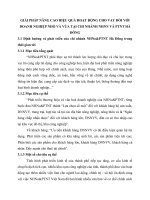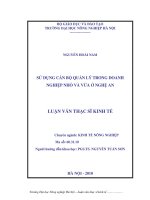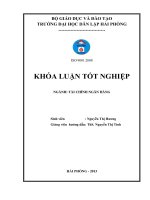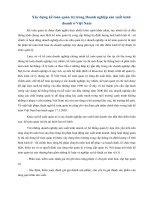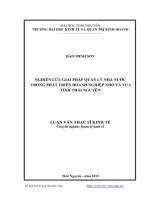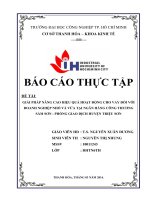Giải pháp nâng cao việc sử dụng kế toán quản trị trong doanh nghiệp nhỏ và vừa tỉnh Thái Nguyên (1)
Bạn đang xem bản rút gọn của tài liệu. Xem và tải ngay bản đầy đủ của tài liệu tại đây (502.66 KB, 18 trang )
THE SOLUTIONS TO ENHANCE THE USE OF MANAGEMENT
ACCOUNTING IN SMALL AND MEDIUM ENTERPRISES
IN THAI NGUYEN PROVINCE
EXECUTIVE SUMMARY
CENTRAL PHILIPPINE UNIVERSITY
DOCTOR IN BUSINESS ADMINISTRATION
TRUONG THI VIET PHUONG
DECEMBER 2016
Title: The solutions to enhance the use of management accounting in small and medium
enterprises in Thai Nguyen Province
Total No. of pages:
Researcher: Truong Thi Viet Phuong
Degree Program: Doctor of Public Administration
Institution: Central Philippine University
Jaro, Iloilo City
Region VI
Rationale/ Introduction of Study
In Vietnam, over the years, SMEs have developed throughout the country and
they are considered the ‘backbone’ of the economy. Currently, along with the process of
economic reform, Vietnam has been actively promoting international economic
integration; especially, Vietnam has joined the World Trade Organization (WTO), a global
trade organization. The process of integration has a strong impact on the economy in
general and businesses as well as SMEs in particular, which has set up a more favorable
business environment, helping SMEs have more opportunities to develop.
When starting the international integration, enterprises in Vietnam in general and
the small and medium-sized enterprises (SMEs) in particular face new opportunities and
challenges. With small production scale, difficulties in access to funding and low-level
employees etc..., especially SMEs are not used to applying management accounting to
operation, so they are at a disadvantage when competing with large corporations and
foreign corporations. Under the general terms when joining the WTO and other trade
organizations such as ASEAN or the signing of free trade agreement between Vietnam and
the Eurasian Economic Union on May 29, 2015, Vietnam has to gradually dismantle tariff
barriers so that trade becomes easier. But it also means that the level of competition will
become more acute (The Working Committee on the Accession to WTO of Vietnam,
2006). However, a worrying problem herein is that Vietnam’s economy has slow reform
from its inside due to the characteristics of transform from subsidized economy into
socialist-oriented market economy. Therefore, SMEs not only take advantage of many
opportunities but also face many difficulties created by integration process.
Once the business environment changes according to the trend of global
integration, Vietnam’s managers must cope with a major challenge which is that they have
to use new management tools in order to respond and increase competitive advantage of
their businesses. Therefore, more than ever SMEs have to rapidly use management
accounting to help managers get the timely, appropriate and effective information to
support the decision-making process. However, because the market economy has been
formed later than other countries in the world, teaching of management accounting in
Vietnam only started in the early 1990s of the 20th century; therefore, today most of the
accounting departments in SMEs in Vietnam are still unfamiliar with the use of
management accounting. Through the author’s preliminary survey as well as previous
researches, so far the application of management accounting to management operations in
SMEs are still limited; consequently, the application rate of management accounting in
SMEs in general is still low, applied technical tools of management accounting are mostly
traditional technical tools and the effectiveness contributed to management affairs is not
high. However, in fact the application of management accounting is influenced by many
factors inside and outside the enterprise, and these factors may increase the feasibility of
applying management accounting in SMEs in Vietnam or and vice versa.
Although 2015 was a difficult year for the national economy in general and
economy of Thai Nguyen Province in particular, with the efforts, creativity and
determination of both political system and business community, the province has
successfully completed its task: Its Gross Regional Domestic Products (GRDP) in 2015
was estimated to increase by 25.2% compared to them in 2014, in which the agriculture,
fishery and forestry increased by 4.8%, contributing 0.84 percentage points to the overall
growth rate; industry and construction went up by 45.5%, contributing 21.4 percentage
points; the service sector increased by 8.4%, contributing 3 percentage points to the overall
growth rate. (according to Report No. 235/BC-UBND dated 13/11/2015 of Thai Nguyen
Provincial People’s Committee on reporting results of implementing socio-economic
development tasks in 2015). To achieve these important results, Thai Nguyen has always
recognized the efforts of enterprises in production and business activities, and their efforts
to overcome difficulties and preserve their sustainable value, maintain life and stable jobs
for their employees, and have effective contributions to the local budget. At the same time,
the enterprises always take good social responsibility, pioneer in poverty reduction,
actively participate in humanitarian activities, charitable activities, social welfare activities,
etc… However, in the situation of international economic integration and multilateral
cooperation at present, the SMEs in Vietnam in general and those in Thai Nguyen Province
in particular are not only under the competitive pressure with domestic companies but also
compete more severely with multinational corporations which are much more powerful in
terms of capital, trademark and management skills. Thus, to be competitive, Vietnamese
SMEs have to find themselves a reasonable path for their own survival and development.
One of the necessary solutions is to save production costs and improve management
efficiency, etc… in which accounting information plays an important role as basic
information. Therefore, if SMEs want to have sustainable development, they must have
good and efficient accounting system. However, few SMEs can accomplish that goal
because most of them are the newly established enterprises with limited capital. Having a
good accounting system requires enterprises to invest heavily, so few companies are able
or dare to do this. Therefore, the commonly current solution is hiring professional
accountants to work overtime or hiring low level ones with affordable costs. Consequently,
businesses will have an inefficient accounting system, not providing timely information for
decision making. Thus, it is urgent to raise the awareness of role of accounting system in
general and management accounting in particular for SMEs to overcome difficulties, enhance
the efficiency of managers’ decision-making for sustainable development of enterprises.
The study evaluating the use of management accounting of SMEs in the province
of Thai Nguyen, identify and analyze the factors affecting the tendency to use management
accounting in Thai Nguyen SMEs, from propose solutions that contribute to improving the
use of management accounting in SMEs Thai Nguyen
Statement of the Problem
• General
Along with systematizing theoretical and practical basis of management
accounting in SMEs, the dissertation will analyze and assess the situation of the role of
corporate management accounting system. It will identify and analyze the factors affecting
the tendency to use management accounting in the SMEs in Thai Nguyen Province to
propose solutions to contribute to enhancement of management accounting use in the
SMEs of Thai Nguyen Province.
• Specific
- Systematizing the theory for SMEs and corporate management accounting
- Assessing the situation and role of corporate management accounting system
- Identifying and analyzing the factors affecting the tendency to use management
accounting in the SMEs in Thai Nguyen Province
- Specifying the nature of limitation and inadequacy of management accounting to
provide the solutions that enhance the efficiency of use of management accounting in the
SMEs in Thai Nguyen Province
Research process of the author as below:
Scientific basics of research:
- Enterprise management, small and
Step 1
medium-sized enterprises.
Documentary research
-
Management accounting.
-
Factors affecting to trend of using
management accounting system.
Prepare Draft survey questions
Select key groups
Step 2
Preliminary Survey
Step 3
Prepare official survey
questions
Data processing:
Descriptive statistical
analysis, correlation
analysis
Inspect
regression
model
Official investigation
Research result
Figure 3.1: Research process
Research process of the author as below:
Step 1: Study and research documents, read and refer to secondary data in reports,
books, papers, newspapers, specialized magazines, websites of enterprises, and etc. as well
as previous researches to capture an overview of topic.
- Systemize theoretical basis of small and medium-sized enterprises, enterprise
management, and contents of management accounting, model, and trend of using
management accounting in enterprises.
- Determine factors affecting to the trend of using management accounting in SMEs.
After that, prepare draft survey questions: Use detailed questionnaires, and directly
discuss to determine information demand. Questionnaire is designed as suggestive and
easy to understand.
Step 2: Bilateral discussion skill and in-depth interview with experts are focused in
this research and it is used to adjust and supplement for theoretical scale of factors
affecting to management accounting usage, then establishing official questionnaire.
Step 3: Official investigation: Directly interview with official questionnaire
(adjusted through the first survey), have explanation of contents, so interviewees can
understand and answer exactly according to their assessments. Data processing, descriptive
statistical analysis, correlative analysis and provide research result.
Study population and ampling Technique
Based on theory as well as establishing expected measurement scale in the first step
to measure factors in proposal research model. Structural equation modeling (SEM)
requires large samples to ensure necessary reliability of model (Raykov and Widaman,
1995, extracted from Nguyen, 2002). However, researchers have still not confirmed what
is considered as large sample. According to Hair & his partners (2010), sample size shall
be considered in relation with estimated parameters and if using maximum likelihood
method (ML), minimum sample size is from 200 to 300. There are many researchers said
that minimum sample size is 2000 (Holter, 1983, extracted from Nguyen Dinh Tho and
Nguyen Thi Mai Trang, 2008). In addition, according to Bolen (1989), necessary rate of
sample size is: need at least five observations per each estimated parameter (5:1 ratio).
According to above discussed, if based on Bolen’s opinion, there is at least five
observations per each estimated parameter, this research has total estimated parameters of
n=30, so minimum sample size is 150 (complying with 5:1 ratio). If based on opinion of
Hair & his partners, minimum sample size is over 150 observations. However, the larger
sample size, the higher requirement of minimum reliability (reduce sampling bias).
This research shall apply probability sampling method with sample size n = 200,
showing chief accountants or enterprise owners working in 200 enterprises with business
registration in Planning and Investment Department of Thai Nguyen province, people
provide information has long experience, actively joining in professional activities of small
and medium-sized enterprises so they understand actual operation status of enterprises in
the province. However, in fact, probability sampling method requires a lot of effort; the
result may be not adequate; therefore, depending on investigating process, the author can
select non-probability sampling according to the suitable trend but still ensure the highest
representative.
Currently, in Thai Nguyen province, there are about 5,000 working enterprises,
including 4,914 domestic enterprises (small and medium-size enterprises account for over
97%) with total registered capital is about 34,669 billion dong, there is 86 FDI enterprises
with total registered capital of over 7.1 billion USD, equal to 155 thousand VND.
Structure, scale, operation sector of enterprise has changes consistent with economic
structure change according to towards increasing the share of industry, service; operation
efficiency and competitive capacity of enterprises is increased, thereby contributing to
development of the province. By the end of 2015, economic growth of the province
reached 25.2%, average GRDP per people reached 46.4 million dong, state budget in 2015
reached 7,285 billion dong; economic structure had clear change: industry and construction
accounted for 49.4%; agriculture, forestry and fishier accounted for 16.6%; service
accounting to 34%; industrial production value reached 365,203 billion dong, reduced
poverty rate to 2% compared with previous year.
Therefore, method of sample selection is non-probability with 200 enterprises in
various business lines are existing and has financial statement, tax statement within at least
3 years until end of December 31, 2015. Enterprises in the survey are limited company and
joint stock company in Thai Nguyen province.
PERFORMANCE SHARE ALLOCATION SURVEY
BY SECTOR
9%
4%
15%
Trade business
11%
Building materials
21%
Construction
11%
Food, Chemical
Aquaculture, agriculture
8%
23%
Mining
Industry manufacturing
Others
Data Processing and Analysis
According to documents of research method, some investigation methods are
recognized: observation, direct interview, interview via telephone, email, investigation via
email, direct investigation. Selecting research method shall depend on target of
investigation and each method has potential advantages and disadvantages.
In above investigation method, direct interview shall have highest respond rate.
Also in this method, investigator can use physical stimulation to support interview. It also
allows investigator to clarify (explain) obscure or complex questions. However, this
method also has potential tendency of prejudice (this also happens in various attitude of
investigating objects), leading to misleading investigation result. In addition, this is also
the most expensive method.
Despite above disadvantages (prejudice tendency, high cost), direct interview still
has advantages (high respond rate, in-depth interview) suit with required purpose of this
research. In addition, high respond rate shall affect to decrease potential deviation
(prejudice tendency). Therefore, this research applies direct interview for investigation and
data collection.
Time for issuing survey form: 15 December 2015 to 15 January 2016.
Selecting investigating objects or information provider is one of important
condition in research of management in accounting – auditing sector, especially the trend
of using management accounting of SMEs in Thai Nguyen province. In order to answer
investigating questions, information provider shall be chief accountant or enterprise owner
of enterprises in Thai Nguyen province, with long experience, actively joining in
specialized, professional operations, managing small and medium enterprise to know
operation status of enterprises in the province.
Design questionnaire
Questionnaire is one tool used to collect data. Questionnaire includes group of
questions and answers arranged in one logical order. Questionnaire is one mean to
communicate between researchers and respondents in all interview method. Normally,
there are eight basic steps to design one questionnaire as below:
(1) Determine required data: based on target and contents of research, to determine
specifically overall research and contents of required data; in this research, it is
measurement of factors affecting to the trend of using management accounting of SMEs in
Thai Nguyen province.
(2) Determine interview method: depending on interview method (email, telephone,
direct interview, email interview, etc.) shall have different questionnaire. In this topic, the
author determined that interview method is direct interview through participants shall
answer and confirm when questionnaire is not clear. (In some cases, far from the author,
the author shall send via email and post, then call to notify and confirm)
(3) Outline contents of questionnaire: Corresponding with content of research,
outline questionnaire. Need to arrange questions according to each topic reasonably. (See
more detail in appendix 4 of the thesis)
(4) Select type of question: There are various questions designed for questionnaire,
however, in this topic, the author uses questions in order of Likert measurement scale with
5 order levels and respondents only read contents and make cross in box with suitable
answer (See more details in appendix 4 of this thesis)
(5) Determine suitable words for questionnaire:
(6) Determine structure of questionnaire: The author shall arrange questions in
logical sequence. These questions shall lead to next questions in reasonable sequence,
according to one continuous thought. A major problem shall be divided into several minor
problems. In answers, also raise questions to continue sorting information. Structure of
questionnaire: including 5 parts:
-Opening: There are cozy effect to make the cooperation of the respondents at the
beginning of the interview.
-Quantitative question: Determine interviewed subjects.
-Warming question: Remind to focus on topic of questionnaire.
-Specific question: Make research contents clearer.
-Sub question: Help to collect more information on characteristics of the
respondents (gender, age, career, etc.)
(7) Design the presentation of questionnaire: questionnaires are designed in A3 or
A4 paper with structure as point (6) and send via email and then printed in A4 paper to
facilitate question, storage and statistic.
(8) Trial to test questionnaire: after setting up, questionnaire will be sent for 30
respondents first (of previous survey) to collect their opinion and adjust final questionnaire
before mass deployment.
After measurement scale of survey factors is inspected, it shall be processed by running
linear regression with minimum ordinal least squares (OLS) with both Enter method and
Stepwise method. After setting up regression model with minimum total square method.
To ensure reliability of model, the author conducts testing satisfaction of theories of OLS
method. Including:
After collecting data from SMEs, it is necessary to check and reject unqualified
questionnaire. Next, conduct to encode data, data entry, clear data. Then analyse data with
support of SPSS 22.0 software and following method:
Analyse reliability with Cronbach’s Alpha coefficient: According to “Hoang
Trong and his partners, 2005”, reliability meets requirements when Cronbach’s Alpha ≥
0,8; Cronbach’s Alpha from 0.6 to above can be used in case research concept is new or
new for interviewer in research context (in case topic – exploration research), so when
testing, shall use Cronbach’s Alpha ≥ 0.6.
Exploratory Factor Analysis: used to shorten multiple, dependent observation
variables to one group with less variables, so they are more meaningful but still contains
information of original variables. (Hair and his partners, 1998). Number of factors:
Determined based on Eigenvalue index representing for fraction of variables explained by
each factor. According to Kaiser standard, these factors having Eigenvalue less than 1 shall
be rejected in research model.
Factor extraction method used in this research is Pricipal Axis Factoring with
Varimax rotation. Principal Axis Factoring method will give us number of minimum factor
to explain common variance of observed variables during interaction between them.
Measurement scales meeting requirements on reliability shall be used to analyse
factors to shortent one group including multiple observed variables to one variable (called
factor); these shortened factor will be more meaning but still containing information of original
observed variable (Hair, Anderson, Tatham and Black; 1998). Exploratory factor analysis EFA
is used to test coneptual value of measurement scale (according to Le Ngoc Duc, 2008).
- Testing Bartlett: observed variables are correlated with each other in the overall.
- Consider value KMO: 0,5 ≤ KMO ≤ 1, factor analysis is stuiable with data; On the
contrary, KMO < 0,5, analyse factor which is possible to not suit with data (Hoang Trong &
Chu Nguyen Mong Ngoc, 2005)
- To analyse EFA with practical value: conducting reject observed variables with load
factor coefficient < 0,5.
- See Eigenvalues (represented for variance explained by each factor) having
value > 1.
- Review total extracted variance (≥ 50% is required): show that extracted factor
explains % of variance of observed variables.
Implementation method and evaluation criteria in exploratory factor analysis EFA:
- Using extracted factor method is Principal components with Varimax rotation and
stop point when extracting factors with Eigenvalues =1. With single-direction scale, use
extracted factor method is Princial components. Reject variables in factors (called load factor
coefficient) less than 0.4 and total extracted variance is equal or more than 50% (accepted
scale) (Gerbing & Anderson, 1988; extracting according to Nguyen Dinh Tho & Nguyen Thi
Mai Trang, 2009).
- Standard for load factor coefficient is more or equal to 0.5 to ensure practical
significance of EFA. Values of load factor coefficent: more than 0.3 is minimum; more than
0.4 is important; more than 0.5 is practical meaning. Standard to select load factor coefficent:
minimum sampling size is 350, can select load factor coefficient > 0,3; if sampling size is
about 100, select load factor coeffient > 0,55; if sampling size is about 50, load factor
coefficient is > 0,75 (Hair, Anderson, Tatham and Black; 2008).
Regression analysis: Used to simulate cause and consequence relationship between
variables, in which one variable called dependent variable and other variables called
independent variables. Suitble level of model is evaluated by adjusted R2. Value of
adjusted R2 doesn’t depend on magnification deviation of R2 so suit with multiple variable
linear regression. Testing ANOVA used in testing suitability of model, it means that it have or
does not have one relationship between independent and dependent variables. The nature of
testing ANOVA is to test F whether dependent variable is linear relating to independent
variables and assume H0 said that βk = 0. F is calculated from value of R2 of full model, value
Sig. is less than testing significance level shall help to confirm the suitability of regression
model. Un-standardized B coefficient reflects variance of Y when one X unit changes. While
standardized Beta coefficient reflect variance of standard deviation of Y, when one standard
deviation of X changes. More specifically, standardized Beta coefficient is result of solving
regression equation in which independent, dependent variables are standardized (variance=1).
Non-standardized B coefficient is result of solving regression equation in which variables
remain original value. Standardization of Beta coefficient used to answer question: which
independent variable has stronger impact to dependent variable when using multiple variable
regresson analysis, when independent variables having different unit. Therefore, we select
coefficient of regression model is non-standardized B coefficient.
- In case residual variance change: The author used correlative Spearman to check
theory of residual variance change.
- Testing multicollinearity in mode: Multicollinearity is one case in which
independent variables correlating closed. Problem of multicollinearity is that they give
model with the same information and difficult to separate affect to each variable. For
multicollinearity, tolerance or variance inflation factor VIF, when VIF is less or equal to 2,
it means independent variables have linear correlation with each other.
- Testing change of variance: Variance change is case that variance of this term is
not the same. When variance of variables change, estimation of regression coefficient is
not effective, testing t and F is not reliable. If magnitude of standardized residual increases
or decreases according to estimation, then assumption of consistent variance is violated.
- Testing autocorrelation: this is one type of violation of basic interference item,
consequence when ignoring correlation is forecast and estimation still remains unbiased
and consistent but not effective. In that case, testing Durbin-Watson is the most common
testing for first-order correlation.
Research hypothesis shall be tested through researched data of regression equation
established. Testing criteria used t statistic and p-value (Sig.) in respect, reliability is taken
as 95%, p-value will be compared directly with 0.05 value to accept or reject research
hypothesis. To review suitability of data and suitability of model, we use R-square
coefficient, t statistic and F to test. In order to evaluate importance of factors, we consider
corresponding Beta coefficient in regression equation established from research data.
Finding
Factors selected as independent variables as Management support, Labor – inventory;
Apply quality standard; Strategic vision; Simplify strategic connection. Dependent variable
is the trend of using management accounting of SMEs in Thai Nguyen city. Both primary
and secondary data were used. Questions and scale shall base on research of Fullerton,
Rosemary and Kennedy, Frances A (2009). Likert measurement scale with 5 points has
been used. Organization as well as supplier, factors and assessment result of research
subjects are stated in Appdendix. Secondary data is collected from annual report of
company. “Descriptative statistic” and “correlation analysis” as well as “OLS linear
regression” are methods used to analyze data. Research models and hypotheses are shown
as below:
The trend of using management accounting
Support of management
Labor - inventory
Apply quality standard
The trend of using
management accounting
Strategic vision
Simply strategic connection
Figure 3.2: Research model
The research result has helped the author answer the two questions raised in the
part of research objectives:
(1) The factors affect to the use of management accounting in SMEs in Thai Nguyen
province
(2) Impact level of each factor to the use of management accounting in SMEs in
Thai Nguyen province
(3) Implication of solutions to enhance the role of the MA in SMEs in Thai
Nguyen province
For the first question, the research result shows that, in research condition at an
enterprise, the factors in original model of Fullerton, Rosemary and Kennedy, Frances A
(2009) do not form different concepts. Specifically, the research of the management
accounting use is subject to direct impact of 5 factors in the assumption model: In which,
the impact factors are Management support, Strategic vision, Strategic Alliance, Inventory
labor; Apply quality standard and dependent variables of the use of management
accounting in SMEs in Thai Nguyen province.
For the second question, the research result shows that the factors positively affect
the use of management accounting in SMEs in Thai Nguyen province, however, their
impact levels are different. In which, the most influential factor is Management support
with β1=0.410 that means this factor explains 40.9% of the impact significance to the
management accounting use in Thai Nguyen province, Strategic alliance is a positive
impact factor to the following model with β4=0.217. Applying the quality standards
positively affects the use of management accounting in SMEs in Thai Nguyen province
with β5=0.148, inventory labor factor also has positive impact with β3=0.146 of the MA
use. Meanwhile, the strategic vision factor positively affects the weakest model with
β2=0.137. At the same time, the analysis result shows that sig of 05 factors are smaller
than 0.05, so we can conclude that these 5 factors have statistical significance. The model
without phenomenon was collinear, variance was changed, linear association and equal
variance of the first regression was not infringed, the distribution of the remainder was
approximately normal. The above factors explained 52.595% of the significance of
regression model of the factors affecting the use of management accounting in SMEs in
Thai Nguyen province.
Management support with β1=0.410, the research result is in line with the previous
research which supports to the opinion of manager’s commitment and the participation of
operation staff that are very important factors in the successful implementation of new
business operation. Ramarapu et al. (1995) concluded that the important factors for the
successful JIT application included manager’s commitment and the staff’s participation.
Similarly, multiple previous scientific research works suggested that the management role
was a strong forecast factor that affects the performance of enterprise from the
interventions such as TPM, TQM, and JIT into production and business operations (Cua et
al, 2001;. Flynn et al.,1995; McLachlin, 1997; Samson and Terziovski, 1999; Ishikawa,
1985; Deming, 1986; Powell, 1995; Ahire and O'Shaughnessy, 1998; Kaynak, 2003). Park
(2003) suggested that the successful implementation of philosophy required that CEO
should deeply understand the philosophy. To succeed, any major change in strategy and
culture of an organization is firstly accompanied with the efforts of senior management
(Kaynak, 2003).
Strategic Alliance with β4=0.217, the experimental research in SMEs in Thai
Nguyen province shows that the management framework of traditional relationship means
the company must be ready to conduct significant changes in their accounting system. The
majority of responders said that the management accounting system of enterprise has not
effectively supported to strategic initiatives. The main reason is the financial analysis,
production and business operation forecast have not performed fully in accordance with
procedures, the enterprise sometimes has good initiatives but due to the lack of impact
factors such as economic impact, unusual changes of policy, non-invested quality
management that lead the forecast, product policy and competitive policy is very difficult.
Therefore, the management does not have favorable conditions to make decision of
strategic planning timely, accurately and scientifically.
Labor and inventory factor with β3=0.146, the research result also unifies the
opinion with previous research to indicate that labor is one of the pillars of production
system (Liker, 2004). This shows that the economic environment should use labor
resources, listen to their feedback and take into account their participation into the decision
making. It is very important when staff is notified about the company’s strategy, and likely
to make operation decisions and adjustments for working (Fullerton and McWatters,
2002). Ittner and Larcker (1995) stated that management accounting plays an important
role in a comprehensive quality management environment that means to authorize the
labors with information to resolve issues and continuously improve activities. In JIT
environment, according to Bank et al. (1993), the labors are entitled to control production
activities that require their participation in resolving problems. In many cases, the
employees in this environment are provided information to allow them monitoring
production procedures (Kennedy and Widener, 2008). The following accounting features
reduce the success of operation environment of enterprise: the dependence in standards; the
emphasis on variance and calculation efficiency; the concern with DL; inventory
monitoring; and cost allocation based on DL (Green et al., 1992). The use of traditional
labor and tools such as volume and efficiency of criteria encourages excess production and
redundant inventory (Fullerton and McWatters, 2004). The solution is management of
cost, labor, inventory and products.
Strategic vision with β3=0.137, the research result in SMEs in Thai Nguyen shows
that it requires the close cooperation among all participants into production and business
process. The cooperation level requires the direct communication among the participants in
the tasks. Using the strategic vision, labors may easily determine the production needs and
communicate with techniques with necessary help. Williams and Sackett (2003) proved
that the data of strategic vision is updated in both history time and actual data as well as the
remedy on time as needed. Parry and Turner (2006) said that the important thing was to
create value strings to authorize to design effectively their own strategic vision and support
business goals. Instead of waiting for the managers to guide the work based on monthly
accounting report, labors are authorized to use the control system of strategic vision
implementation process to monitor their efficiency. To enhance the effectiveness of
strategic vision in management accounting, the enterprises should perform the solutions
such as training to enhance knowledge, encouraging staff to monitor, resolving problems
of the company together, quality management, and improving effectiveness of the
available training source.
Apply quality standards (β2=0.137), stable flow of products is maintained during
the activities and focusing on production is to determine to remove waste. In this
environment, the labors must be provided accurate information to determine and limit
waste and troubles promptly (Maskell and Baggaley, 2004). Although the scholars have
warned for years that the current accounting systems are out of date for new production
environments, most researches show that the companies continue based on regular
accounting systems, even in sophisticated production environment (Fullerton and
McWatters, 2004). Currently, the companies in Thai Nguyen province have not reduced
inventory effectively, consequence is that business efficiency has not really met the
expected requirements, the work establishment is still waste of time leading the work
efficiency and productivity has not met the requirements. According to survey of quality
verification system, the enterprises’ representatives regularly apply Kaizen standard and 5S
model. This provides management implication on quality standard application, the
implication
content
includes
inventory
management,
work
establishment
time
management, application of Kaizen standard and 5S model.
It can say that financial accounting for Vietnamese enterprises is currently the most
focused part because the requirements on information provision for enterprise management
are always in place. On 12 June 2016, Circular No. 53/2006/TT-BTC of Ministry of
Finance on “Guiding the application of management accounting in enterprise” was
formally issued in order to help the enterprises to conduct the management accounting.
Most enterprises in Thai Nguyen province, especially small and medium enterprises which
were investigated know this Circular which proves that they also study it at certain level. In
fact, however, a few enterprises did not know this Circular that means a part of SMEs in
the province has not paid attention satisfactorily to the first significant document to guide
the enterprises to apply management accounting – since management accounting was
formed and developed in Vietnam. Generally, since its inception to now, management
accounting in enterprises was still finding its path, there has not any organization that is
enough expertise and experience to consult and develop management accounting system.
The management accounting system does not have any generally legal regulations in
both report form and content. Currently, only large enterprises use uniform management
software system, and most small and medium enterprises only apply accounting software,
therefore they only use information source from financial accounting. This is a reason causing
the data gathering encounters errors and untimely. In fact, the enterprises with internal
investment which use accounting information for management purpose are still limited.
Conclusion
The research result from 200 SMEs in Thai Nguyen province shows that the use of
management accounting in SMEs is subject to the direct impact of 5 factors in the
assumption model: In which, the impact factors are Management support, Strategic vision,
Strategic alliance, Inventory labor; Apply quality standard and dependent variable of the
use of management accounting in SMEs in Thai Nguyen province. In which, the most
influential factor is Management support explaining 40.9% of the impact significance to
the management accounting use in Thai Nguyen province, Strategic alliance is a following
positive impact factor to the model. Next is Apply the quality standards positively affects
the use of management accounting, inventory labor factor also has positive impact with
equal level. Meanwhile, the strategic vision factor positively affects the weakest model but
regression coefficient is more than 13%. At the same time, the analysis result shows that
sig of 05 factors are smaller than 0.05, so we can conclude that these 5 factors have
statistical significance. The model without phenomenon was collinear, variance was
changed, linear association and equal variance of the first regression was not infringed, the
distribution of the remainder was approximately normal. The above factors explained
52.595% of the significance of regression model of the factors affecting the use of
management accounting in SMEs in Thai Nguyen province.
Recommendations
The research suggests some solution to enhance the use of management accounting
in small and medium – sized enterprise in Thai Nguyen Province.
To the Government and its relevant departments:
The Government and the Ministry of Finance should promptly issue common rules
and more specific guidance on the organization of management accounting for businesses,
especially that for SMEs. After that, they should support enterprises in training and
retraining human resources who are capable of researching, implementing and applying
management accounting to businesses.
To SMEs:
They must innovate, improve and solve the following problems to survive and
thrive in the market economy:
They must improve the awareness of the role of management accounting. In fact,
managers still operate their businesses through their subjective judgment and experience
rather than understanding and proper awareness of the importance of management
accounting in business management. Therefore, they do not pro-actively build a suitable
management accounting model for their businesses. The first thing the administrator
should do is improving the awareness of management accounting.
They must improve management organization and technology in production and
business, building and perfecting management mechanism, internal control, organization
and management structure to ensure the best connection among the parts of the enterprise,
providing adequate and timely information for the collection and processing of information
for management accounting.
They must organize their accounting system and divide the work of financial
accounting and management accounting reasonably, assigning suitable tasks basing on
qualifications and professional competence, retraining accounting personnel to serve
management accounting, rapidly developing and improving automatic information
processing to meet the requirements of providing timely information for management
accounting.



